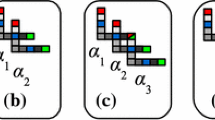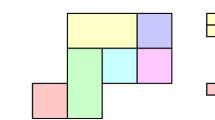Abstract
In this paper we consider the time complexity of adding two n-bit numbers together within the tile self-assembly model. The (abstract) tile assembly model is a mathematical model of self-assembly in which system components are square tiles with different glue types assigned to tile edges. Assembly is driven by the attachment of singleton tiles to a growing seed assembly when the net force of glue attraction for a tile exceeds some fixed threshold. Within this frame work, we examine the time complexity of computing the sum of two n-bit numbers, where the input numbers are encoded in an initial seed assembly, and the output sum is encoded in the final, terminal assembly of the system. We show that this problem, along with multiplication, has a worst case lower bound of \(\varOmega ( \sqrt{n} )\) in 2D assembly, and \(\varOmega (\root 3 \of {n})\) in 3D assembly. We further design algorithms for both 2D and 3D that meet this bound with worst case run times of \(O(\sqrt{n})\) and \(O(\root 3 \of {n})\) respectively, which beats the previous best known upper bound of O(n). Finally, we consider average case complexity of addition over uniformly distributed n-bit strings and show how we can achieve \(O(\log n)\) average case time with a simultaneous \(O(\sqrt{n})\) worst case run time in 2D. As additional evidence for the speed of our algorithms, we implement our algorithms, along with the simpler O(n) time algorithm, into a probabilistic run-time simulator and compare the timing results.











Similar content being viewed by others
Notes
This subtle issue seems to exist with some previous formulations of tile assembly computation.
References
Abel Z, Benbernou N, Damian M, Demaine E, Demaine M, Flatland R, Kominers S, Schweller R (2010) Shape replication through self-assembly and RNase enzymes. In: SODA 2010: proceedings of the twenty-first annual ACM-SIAM symposium on discrete algorithms (Austin, Texas), Society for Industrial and Applied Mathematics
Adleman L, Cheng Q, Goel A, Huang M-D (2001) Running time and program size for self-assembled squares. In: Proceedings of the thirty-third annual ACM symposium on theory of computing (New York, NY, USA), ACM, pp 740–748
Adleman LM, Cheng Q, Goel A, Huang M-DA, Kempe D, de Espanés PM, Rothemund Paul WK (2002) Combinatorial optimization problems in self-assembly. In: Proceedings of the thirty-fourth annual ACM symposium on theory of computing, pp 23–32
Becker F, Rapaport I, Rémila E (2006) Self-assembling classes of shapes with a minimum number of tiles, and in optimal time. Foundations of Software Technology and Theoretical Computer Science (FSTTCS), pp 45–56
Brun Y (2007) Arithmetic computation in the tile assembly model: addition and multiplication. Theor Comput Sci 378:17–31
Bryans N, Chiniforooshan E, Doty D, Kari L, Seki S (2011) The power of nondeterminism in self-assembly. In: SODA 2011: proceedings of the 22nd annual ACM-SIAM symposium on discrete algorithms, SIAM, pp 590–602
Chandran H, Gopalkrishnan N, Reif JH (2009) The tile complexity of linear assemblies. In: 36th international colloquium on automata, languages and programming, vol 5555
Cheng Q, Aggarwal G, Goldwasser MH, Kao M-Y, Schweller RT, de Espanés PM (2005) Complexities for generalized models of self-assembly. SIAM J Comput 34:1493–1515
Cheng Q, Goel A, de Espanés PM (2004) Optimal self-assembly of counters at temperature two. In: Proceedings of the first conference on foundations of nanoscience: self-assembled architectures and devices
Cook M, Fu Y, Schweller RT (2011) Temperature 1 self-assembly: deterministic assembly in 3d and probabilistic assembly in 2d. In: Dana R (ed) Proceedings of the twenty-second annual ACM-SIAM symposium on discrete algorithms, SODA 2011. SIAM, pp 570–589
Demaine E, Patitz M, Rogers T, Schweller R, Summers S, Woods D (2013) The two-handed tile assembly model is not intrinsically universal. In: Proceedings of the 40th international colloquium on automata, languages and programming (ICALP 2013)
Demaine ED, Demaine ML, Fekete SP, Patitz MJ, Schweller RT, Winslow A, Woods D (2014) One tile to rule them all: simulating any tile assembly system with a single universal tile. In: ICALP 2014: proceedings of the 41st international colloquium on automata, languages and programming
Doty D (2010) Randomized self-assembly for exact shapes. SIAM J Comput 39(8):3521–3552
Doty D, Patitz MJ, Reishus D, Schweller RT, Summers SM (2010) Strong fault-tolerance for self-assembly with fuzzy temperature. In: Proceedings of the 51st annual IEEE symposium on foundations of computer science (FOCS 2010), pp 417–426
Doty D, Lutz JH, Patitz MJ, Schweller R, Summers SM, Woods D (2012) The tile assembly model is intrinsically universal. In: FOCS 2012: proceedings of the 53rd IEEE conference on foundations of computer science
Fu B, Patitz MJ, Schweller R, Sheline R (2012) Self-assembly with geometric tiles. In: ICALP 2012: proceedings of the 39th international colloquium on automata, languages and programming (Warwick, UK)
Kao M-Y, Schweller RT (2008) Randomized self-assembly for approximate shapes. In: International colloqium on automata, languages, and programming, lecture notes in computer science, vol 5125. Springer, pp 370–384
Keenan A, Schweller RT, Sherman M, Zhong X (2013) Fast arithmetic in algorithmic self-assembly. CoRR arXiv:1303.2416
Mao C, LaBean TH, Relf JH, Seeman NC (2000) Logical computation using algorithmic self-assembly of DNA triple-crossover molecules. Nature 407(6803):493–496
Meunier P-E, Patitz MJ, Summers SM, Theyssier G, Winslow A, Woods D (2014) Intrinsic universality in tile self-assembly requires cooperation. In: Proceedings of the twenty-fifth annual ACM-SIAM symposium on discrete algorithms
Schilling M (1990) The longest run of heads. Coll Math J 21(3):196–207
Schweller R, Sherman M (2013) Fuel efficient computation in passive self-assembly. In: SODA 2013: proceedings of the 24th annual ACM-SIAM symposium on discrete algorithms, SIAM, pp 1513–1525
Winfree E (1998) Algorithmic self-assembly of DNA. Ph.D. thesis, California Institute of Technology, June 1998
Woods D, Chen H-L, Goodfriend S, Dabby N, Winfree E, Yin P (2012) Efficient active self-assembly of shapes. Manuscript
Acknowledgments
We would like to thank Ho-Lin Chen and Damien Woods for helpful discussions regarding Lemma 4 and Florent Becker for discussions regarding timing models in self-assembly. We would also like to thank Matt Patitz for helpful discussions of tile assembly simulation. The authors were supported in part by National Science Foundation Grant CCF-1117672.
Author information
Authors and Affiliations
Corresponding author
Rights and permissions
About this article
Cite this article
Keenan, A., Schweller, R., Sherman, M. et al. Fast arithmetic in algorithmic self-assembly. Nat Comput 15, 115–128 (2016). https://doi.org/10.1007/s11047-015-9512-7
Published:
Issue Date:
DOI: https://doi.org/10.1007/s11047-015-9512-7




